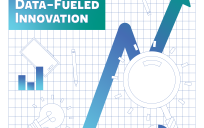On GovLoop Insights’ DorobekINSIDER:
-
When DVD’s came out, the experts predicted the end of movie theaters. When Amazon set up shop in cyberspace, the experts predicted the end of strip malls. But neither of those things happened. Is the same true for E-Learning? We go myth busting with the Morino Institute.
You can find all of our programs online: DorobekINSIDER.com and GovLoop Insights at http://insights.govloop.com.
But up front: What are your big data challenges?
 Big data — everybody talks about it, but what are the real challenges out there?
Big data — everybody talks about it, but what are the real challenges out there?
Each month, GovLoop’s DorobekINSIDER is live as we work to share information to help you do your job better. I have mentioned that next week, we will be discussing the Internet of Things. (More info here and here; register here) and what the Internet of Things will mean to government.
But we are already thinking about April. Our topic is much discussed: Big data. Here is the GovLoop Guide: Innovations That Matter: Examining the Big Data Frontier
Although we are living in historic times, today’s Digital Age holds many parallels to the industrial revolution. During that era, there were countless breakthroughs in manufacturing, creations of new products, workforce changes and movements to create unions to protect workers’ rights. These advancements were all shaped and sculpted by the technological advancements of the 18th and 19th centuries.
And I was reading an interesting piece in McKinsey Quarterly about data analytics
Views from the front lines of the data-analytics revolution [McKinsey Quarterly] At a unique gathering of data-analytics leaders, new solutions began emerging to vexing privacy, talent, organizational, and frontline-adoption challenges.
Many of the challenges discussed — in a private sector context here — are true for the public sector as well:
-
Data and analytics aren’t overhyped—but they’re oversimplified
-
Privacy concerns must be addressed—and giving consumers control can help
-
Talent challenges are stimulating innovative approaches—but more is needed
-
You need a center of excellence—and it needs to evolve
-
Two paths to spur adoption—and both require investment
As we begin to flesh out how to help government do its job better, what can we do to help?
I’ll share some thoughts ahead, but if you have ideas, let me know.
The SEVEN stories that impact your life:
-
Washington Business Journal: Cisco latest company to part ways with TechAmerica – “A Cisco spokesman did not provide a reason for the decision, but confirmed Cisco joined the Professional Services Council, the Arlington-based trade group that today announced an expansion to bring tech companies further into the fold.”
-
Federal Times: Marine Corps strategy could enable BYOD – “The Marine Corps is banking on a new approach for managing its mobile devices — one that that could pave the way for civilian and uniformed personnel to use their own smartphones for work.”
-
Federal Times: Bill changes TSP default fund – “New federal employees using the Thrift Savings Plan would be automatically enrolled in an “age-appropriate” retirement fund under a bill that Wednesday cleared the House Oversight and Government Reform Committee.”
-
Federal News Radio: Budget seeks largest increase in federal civilian workforce since 2009 – “After years of flat or even declining staffing levels at agencies across the federal government, the Obama administration wants most agencies to begin staffing up again.”
-
Washington Post: House Republican slams Lois Lerner in report on IRS targeting – “A top House Republican on Tuesday released a scathing report on Lois Lerner’s involvement in the Internal Revenue Service’s scrutiny of advocacy groups, accusing the former IRS official of trying to crack down on conservative nonprofit organizations that have grown increasingly influential in recent elections.”
-
Defense News: New US Navy Counting Rules Add Up To More Ships – “You might have missed it, but virtually overnight the US Navy just grew, from 283 battle force ships to 291. A windfall purchase? A fast-track transfer? No, just a new way of counting the ships that carry out the Navy’s missions.”
-
Governing: States Neglect Road Repairs – “States are spending too much on new roads while neglecting their existing transportation network, according to a new report by two research and advocacy groups: Smart Growth America, which seeks to curb urban sprawl and worsening environmental conditions, and Taxpayers for Common Sense, which searches federal budgets for wasteful spending.”
DorobekINSIDER water-cooler fodder… yes, we’re trying to help you make your water-cooler time better too…
-
Forbes: 2014’s Most Valuable Employee: The Social Intrapreneur – This year promises to be a tipping point for a growing group of corporate innovators, who are taking on initiatives that do well for their companies and also do good for society. Social intrapreneurs are quickly becoming the most valuable employees at many companies because they are good for the bottom line, good for the brand, and good for staff morale. They are being recognized as key players in tackling the world’s biggest problems like poverty, hunger, and the need for universal education. Social intrapreneurs are making traditional CSR models look irrelevant, while also setting important examples for larger nonprofits and civic institutions that struggle with tight budgets and sustainability in their donor-driven charity and development work. By adapting entrepreneurial and start-up strategies, employees in the public and non-profit sectors stand to improve their organizations with hybrid value models, cost saving innovation, and increased efficiencies.
-
NSA Nominee Promotes Cyberwar Units [The New York Times] Citing cyberattacks on the new Ukrainian government, President Obama’s nominee to run the National Security Agency, Vice Adm. Michael S. Rogers, said “cyber will be an element of every crisis.”
-
US Companies Cling to Writing Paper Checks [The Wall Street Journal] These days it’s easier than ever to pay for goods and services – without cash, card, pen or paper featuring anywhere near the transaction. Most financial obligations can even be met with just a few taps on a smartphone screen. But for American businesses, the old-fashioned paper check remains the preferred payment method, writes CFO Journal’s Vipal Monga, and that legacy comes at a cost. A survey last September by the Association for Financial Professionals found U.S businesses still pay half their bills by check. “In this day and age it doesn’t make sense,” says Mr. Ken Goldman, chief financial officer of Black Duck Software Inc., which employees 200 staff. “It’s like sending a letter when there’s email.” Paying by check when a computer screen will do is not just a question of making sense, or of being a more efficient use of the CFO’s time: it’s costing the U.S economy. Issuing and depositing checks cost U.S. businesses between $26 billion and $54 billion in 2010, according to MineralTree Inc., an electronic-payments company. And Bank of America estimates that a business check can cost an aggregate of $4 to $20, based on the price of the check and shipping, plus the time employees spend writing, mailing, collecting and reconciling the check. In e-payments, U.S. companies lag behind Europe, Japan and Brazil. American businesses and consumers wrote 21 billion checks in 2012, according to the Federal Reserve. The European Central Bank says that’s more than four times as many checks as were written that year in the European Union’s 28 member countries.
-
Related: 70% of U.S. Government Spending Is Writing Checks To Individuals [Slashdot via Investor’s Business Daily ] Buried deep in a section of President Obama’s budget, released this week, is an eye-opening fact: This year, 70% of all the money the federal government spends will be in the form of direct payments to individuals, an all-time high. In effect, the government has become primarily a massive money-transfer machine, taking $2.6 trillion from some and handing it back out to others. These government transfers now account for 15% of GDP, another all-time high. In 1991, direct payments accounted for less than half the budget and 10% of GDP. What’s more, the cost of these direct payments is exploding. Even after adjusting for inflation, they’ve shot up 29% under Obama.” More from Investors Business Daily




Leave a Reply
You must be logged in to post a comment.